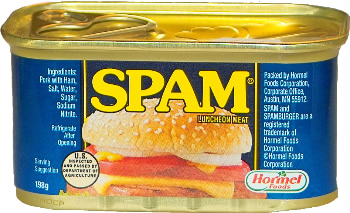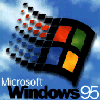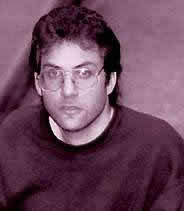click on the home button to go to the home page
|
The Industrial Era 1994 -1995 Internet
is the new hype in computer world. Companies are converging towards
Internet business and building applications for it. Multi Media machines are becoming a de facto standard Since the material shown here is not yet of historic value, seeing the time that elapsed since 1994. The editors felt to display in this and the next chapters the new trends in computing. |
pre history | antiquity
| pre industrial era | industrial
era
1947 -
1950 - 1952 - 1955
- 1958 - 1961 - 1963
- 1965 - 1969 - 1970
- 1972 - 1974 - 1976
- 1978 - 1980 -
1981 - 1982 - 1984 - 1986
- 1989 - 1991 - 1993
- 1994
- 1996 - 2000 - 2002
| Related Articles |
| Related Resources |
![]() The Internet has grown to more
than 25 million users.
The Internet has grown to more
than 25 million users.
Due to this massive influx, conflicts arise between the old and new users. The
old users are best described as from the scientific world, the hackers scene
or users who use the net for professional purposes.
The new users were characterized by not obliging to the 'netti-quette',
a set of undiscribed rules which every user should adhere to. They are corrected
by the Internet community by means of the so-called "flames" (hate-mail")
in which the addressee will be made clear what he/she did wrong.
 |
Many companies are starting to use the net as a cheap way to advertise.
Other companies are using the net to keep in touch with their clients
and give support via the internet. A well publicized case of net pollution, later this use of the internet will be called SPAM, is the case "Canter and Siegel", a law firm in the USA which used the net to advertise practically to all users of all active BBS's of the net. In their advertisement they tried to obtain customers for the application of a Green Card" (a permit for foreigners to stay in the USA). The reaction varied from flames to uncalled subscriptions on tens of magazines, meters of blank faxes and a program of a Norwegian programmer who developed the mechanism of Cancelbot. Cancelbot is a program which erases all e-mail of this firm on any computer before it can reach the user. |
![]() Microsoft, at this moment the
largest software producer on the world with annual sales of over 4 billion US$,
is forced by the American Federal Court to change its code of conduct for marketing.
Microsoft, at this moment the
largest software producer on the world with annual sales of over 4 billion US$,
is forced by the American Federal Court to change its code of conduct for marketing.
The founder and chairperson of Microsoft, Bill Gates, promises to remove the
anti competition clauses from contracts with other software makers. And an improved
separation between the software developers for the Window environment and the
developers for applications. This will weaken the monopolistic position that
Microsoft holds and that is exactly what the federal court wants.
![]() Halfway this year it seems that
the Pentium processor has a design flaw in its multiplication tables. Not all
divisions and multiplications are correct. In the beginning Intel tries to play
down or even ignore the complaint by announcing only mathematicians could prove
this error. In November, IBM and Compaq are quitting the sales of Pentium computers
to increase pressure on Intel. That company still bagatelles the problem, the
error only shows once every 27.000 calculations. The increasing pressure Intel
finally complies to replace those processors for users who do computation related
work. Through this Intel lost almost all its goodwill and many users are changing
to other platforms (Alpha and DEC to the PowerPC from the Apple/IBM/Motorola
consortium). Big computer manufacturers are looking seriously to replace CPU's
with those from AMD and Cyrix.
Halfway this year it seems that
the Pentium processor has a design flaw in its multiplication tables. Not all
divisions and multiplications are correct. In the beginning Intel tries to play
down or even ignore the complaint by announcing only mathematicians could prove
this error. In November, IBM and Compaq are quitting the sales of Pentium computers
to increase pressure on Intel. That company still bagatelles the problem, the
error only shows once every 27.000 calculations. The increasing pressure Intel
finally complies to replace those processors for users who do computation related
work. Through this Intel lost almost all its goodwill and many users are changing
to other platforms (Alpha and DEC to the PowerPC from the Apple/IBM/Motorola
consortium). Big computer manufacturers are looking seriously to replace CPU's
with those from AMD and Cyrix.
In December Intel admits the error fully and replaces all offered processors
with errors, but it looks like a little too late for this giant.
![]() First Internet bank opens. First
Virtual, the first online bank, is launched. (10)
First Internet bank opens. First
Virtual, the first online bank, is launched. (10)

![]() Netscape
founded.
Netscape
founded.
Marc Andreesen, a recent University of Illinois graduate, and Jim Clark, founder
of Silicon Graphics, team up to form Netscape. The pair initially call the company
Mosaic Communications, after the free Web browser that Andreesen helped write
and distribute over the Internet in 1993, but change the name based on legal
objections. The company goes public in August 1995 and will be purchased by
America Online in 1999. (10)
![]() Yahoo launched.
Yahoo launched.
 Stanford
University doctoral students Jerry Yang and David Filo begin compiling an online
database of Web sites as a personal hobby. They post the database on a Stanford
Web server. By 1995, heavy traffic forces them to relocate the site to servers
at Netscape. The company goes public in 1996. (10)
Stanford
University doctoral students Jerry Yang and David Filo begin compiling an online
database of Web sites as a personal hobby. They post the database on a Stanford
Web server. By 1995, heavy traffic forces them to relocate the site to servers
at Netscape. The company goes public in 1996. (10)
![]() Gary Kildall killed in a brawl
(July)
Gary Kildall killed in a brawl
(July)
On July 6, Gary Kildall, inventor of an early personal computer operating system,
is killed in a brawl at a biker bar in Monterey. Before the development of the
IBM PC and the dominance of MS-DOS, almost all personal computers ran on CP/M,
Kildall's operating system. In 1980 Kildall rejected an offer from IBM to license
his operating system to run the new IBM PC. Instead, IBM bought a simple operating
system from Bill Gates for $50,000, ensuring Microsoft's future (10)prosperity.
![]() World Wide
Web Consortium founded (December)
World Wide
Web Consortium founded (December)
![]() The
newly formed World Wide Web Consortium holds its first meeting at M.I.T. in
Cambridge, Massachusetts. The group, which chooses Web inventor Tim Berners-Lee
as its first director, is an international association to promote common protocols
on the Web.(10)
The
newly formed World Wide Web Consortium holds its first meeting at M.I.T. in
Cambridge, Massachusetts. The group, which chooses Web inventor Tim Berners-Lee
as its first director, is an international association to promote common protocols
on the Web.(10)
![]() Leonard Adleman
took a giant step towards a different kind of chemical or artificial biochemical
computer. He used fragments of DNA to compute the solution to a complex graph
theory problem. Adleman's method utilizes sequences of DNA's molecular sub units
to represent vertices of a network or `"graph". (the famous Traveling
Salesman problem for example)
Leonard Adleman
took a giant step towards a different kind of chemical or artificial biochemical
computer. He used fragments of DNA to compute the solution to a complex graph
theory problem. Adleman's method utilizes sequences of DNA's molecular sub units
to represent vertices of a network or `"graph". (the famous Traveling
Salesman problem for example)
Thus, combinations of these sequences formed randomly by the massively parallel
action of biochemical reactions in test tubes described random paths through
the graph. Using the tools of biochemistry, Adleman was able to extract the
correct answer to the graph theory problem out of the many random paths represented
by the product DNA strands.
Like a computer with more than one processor, this type of DNA computer is able
to consider many solutions to a problem simultaneously. Moreover, the DNA strands
employed in such a calculation (approximately 10^23) are many orders of magnitude
greater in number and more densely packed than the processors in today's most
massively parallel electronic supercomputer. (2)(3)(4)
![]() IBM announces PC DOS 7, with
integrated data compression from Stac Electronics (Stacker).
IBM announces PC DOS 7, with
integrated data compression from Stac Electronics (Stacker).
![]() ESCOM announces the creation
of a subsidiary company, Amiga Technologies, in Germany.
ESCOM announces the creation
of a subsidiary company, Amiga Technologies, in Germany.
![]() US District Court Judge Thomas
Jackson approves the consent decree between Microsoft and the US Department
of Justice. The decree will govern Microsoft's licensing practices of Windows
for the next 6.5 years, barring it from linking unrelated software licenses.
The ruling comes after 4 years of investigation of monopolistic licensing practices.
US District Court Judge Thomas
Jackson approves the consent decree between Microsoft and the US Department
of Justice. The decree will govern Microsoft's licensing practices of Windows
for the next 6.5 years, barring it from linking unrelated software licenses.
The ruling comes after 4 years of investigation of monopolistic licensing practices.

![]() Microsoft
releases Windows 95 in August. More than 20,000 retail stores offer copies for
sale. Microsoft prepares for support calls, with 1600 people staffing tech support
lines.
Microsoft
releases Windows 95 in August. More than 20,000 retail stores offer copies for
sale. Microsoft prepares for support calls, with 1600 people staffing tech support
lines.
![]() At the ANA Hotel in San Francisco,
Intel announces the Pentium Pro microprocessor, at speeds of 150-, 180-, and
200 MHz, available initially for US$974 to US$1682. The processor uses 5.5 million
transistors. Bus speed is 60 MHz. Performance of the 200-MHz version is 440
MIPS.
At the ANA Hotel in San Francisco,
Intel announces the Pentium Pro microprocessor, at speeds of 150-, 180-, and
200 MHz, available initially for US$974 to US$1682. The processor uses 5.5 million
transistors. Bus speed is 60 MHz. Performance of the 200-MHz version is 440
MIPS.
![]() Amigo Technologies ships the
A4000T microcomputer. It features a 25 MHz Motorola 68040 microprocessor (or
50 MHz 68060), 2 MB chip RAM, 24-bit color, 4-channel stereo sound, IDE and
SCSI II adapters, 3.5 inch 880 KB floppy drive, 1 GB hard drive, and the AmigaOS
3.1 operating system.
Amigo Technologies ships the
A4000T microcomputer. It features a 25 MHz Motorola 68040 microprocessor (or
50 MHz 68060), 2 MB chip RAM, 24-bit color, 4-channel stereo sound, IDE and
SCSI II adapters, 3.5 inch 880 KB floppy drive, 1 GB hard drive, and the AmigaOS
3.1 operating system.
![]() Hacker Kevin Mitnick arrested
Hacker Kevin Mitnick arrested

 Kevin
Mitnick is arrested on suspicion of stealing twenty thousand credit card numbers
from Internet service provider Netcom. Authorities accuse Mitnick of exploiting
a security hole that allowed him to enter Netcom's computer system. Mitnick
will serve a year in prison after his 1988 conviction for stealing $1 million
in software from Digital Equipment Corp (10)
Kevin
Mitnick is arrested on suspicion of stealing twenty thousand credit card numbers
from Internet service provider Netcom. Authorities accuse Mitnick of exploiting
a security hole that allowed him to enter Netcom's computer system. Mitnick
will serve a year in prison after his 1988 conviction for stealing $1 million
in software from Digital Equipment Corp (10)
pictures shown are Kevin during his arrest (left and during a talk he gave (right)
![]() Microsoft Network launches Microsoft's
online service, the Microsoft Network, launches in the fall of 1995. The service
touts specially developed Web "shows," but users prove more interested
in surfing the Internet than in perusing Microsoft's content. The service is
later reinvented as an Internet service provider. (10)
Microsoft Network launches Microsoft's
online service, the Microsoft Network, launches in the fall of 1995. The service
touts specially developed Web "shows," but users prove more interested
in surfing the Internet than in perusing Microsoft's content. The service is
later reinvented as an Internet service provider. (10)
![]() Network Solutions protects trademarks
Network Solutions protects trademarks
Network Solutions refuses to register copyrighted names as URL's to parties
who do not hold the copyright. Domain name pirates had been registering corporation
names, then trying to sell them back to the company. (10)
![]() The Wall Street Journal launches
site
The Wall Street Journal launches
site ![]()
The Wall Street Journal launches a Web site called Money and Investing Update.
The site, which provides frequently updated business news and statistics, is
the Journal's first step toward launching its popular interactive edition, which
becomes one of the few Web publications to successfully charge a subscription
fee. (10)
![]() RealAudio launched
RealAudio launched
 RealNetworks
launches the popular RealAudio streaming audio program. The launch of streaming
technologies on the Web promises to give users faster access to audio and video.
Microsoft buys 10 percent of the company in 1997 and agrees to support RealAudio
in its Internet Explorer browser. (10)
RealNetworks
launches the popular RealAudio streaming audio program. The launch of streaming
technologies on the Web promises to give users faster access to audio and video.
Microsoft buys 10 percent of the company in 1997 and agrees to support RealAudio
in its Internet Explorer browser. (10)
![]() Sun develops Java
Sun develops Java
 Sun
Microsystems develops Java, a platform-independent programming language. Because
Java programs can theoretically run on any operating system, the language has
the potential to dethrone Microsoft Windows 95. Sun and Microsoft lock horns
over Java several times in the next few years: Microsoft licenses the technology,
but Sun alleges the company has developed its own version that makes programs
run better in conjunction with Microsoft software. (10)
Sun
Microsystems develops Java, a platform-independent programming language. Because
Java programs can theoretically run on any operating system, the language has
the potential to dethrone Microsoft Windows 95. Sun and Microsoft lock horns
over Java several times in the next few years: Microsoft licenses the technology,
but Sun alleges the company has developed its own version that makes programs
run better in conjunction with Microsoft software. (10)
![]() Time Warner sells ads on Pathfinder
(April)
Time Warner sells ads on Pathfinder
(April)
Time Warner becomes one of the first companies to sell advertising on the Web
when it offers space on its Pathfinder site. Sponsors like AT&T and General
Motors Corp. pay $30,000 a quarter to advertise. Although initial ads are met
with criticism by the Web counterculture, Internet advertising soon becomes
a multimillion-dollar industry. (10)
![]() Amazon.com sells its first book
(September)
Amazon.com sells its first book
(September)
![]() Amazon.com
sells its first book online. By 1996, the site is attracting more than 2,000
visitors a day. By 1997, that number will increase to 50,000 a day. From $511,000
in 1995, sales will grow to some $147 million in 1997. The company will go public
in 1997 at eighteen dollars, and by the summer of 1999, stock will be selling
for more than $100 a share. (10)
Amazon.com
sells its first book online. By 1996, the site is attracting more than 2,000
visitors a day. By 1997, that number will increase to 50,000 a day. From $511,000
in 1995, sales will grow to some $147 million in 1997. The company will go public
in 1997 at eighteen dollars, and by the summer of 1999, stock will be selling
for more than $100 a share. (10)
![]() Bill Gates embraces the Web (December)
Bill Gates embraces the Web (December)
Bill Gates announces that Microsoft will shift its entire business focus to
the Internet. He says Miscrosoft Network (MSN), the company's newly launched
online service, will move all of its content to the Web. Despite the company's
ambitious content plans, many of its Web content ventures are scrapped just
a few years later. (10)
![]() AltaVista launches online Web
database (December)
AltaVista launches online Web
database (December)
![]() Search
engine AltaVista launches. The search engine is developed at Digital Equipment
Corp.'s (DEC) research laboratory. Compaq Computer Corp. acquires AltaVista
in 1998 when it buys DEC but later sells a majority interest to venture capital
firm CMGI, Inc.. (10)
Search
engine AltaVista launches. The search engine is developed at Digital Equipment
Corp.'s (DEC) research laboratory. Compaq Computer Corp. acquires AltaVista
in 1998 when it buys DEC but later sells a majority interest to venture capital
firm CMGI, Inc.. (10)
![]() Toy Story is the first full-length
feature film to be completely computer generated.(1)
Toy Story is the first full-length
feature film to be completely computer generated.(1)
![]()
| Last Updated on July 21, 2004 | For suggestions please mail the editor in chief |
Footnotes & References